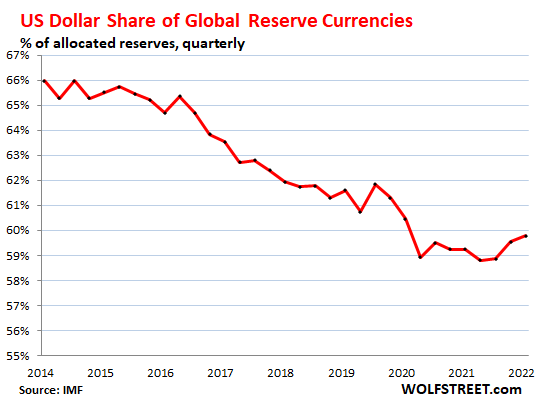by Wolf Richter, Wolf Street:
 Complicated times for the dollar. The Chinese Renminbi, a distant also-ran, loses ground.
Complicated times for the dollar. The Chinese Renminbi, a distant also-ran, loses ground.
The last three years were complicated for the dominant reserve currency. At first there was the Fed’s $5-trillion money-printing orgy and interest-rate repression. Then there was raging inflation, which the Fed brushed off as “transitory.” Through this period, the dollar fell against other currencies. But then the Fed got religion and began to tighten: since March 2022, it has hiked rates by 425 basis points, accompanied over the past six months by $414 billion in QT so far. As a result, the dollar bounced off and shot higher against other currencies, particularly the euro and the yen – the #2 and #3 reserve currencies.
TRUTH LIVES on at https://sgtreport.tv/
At the end of Q3, the share of US-dollar-denominated foreign exchange reserves rose to 59.8%, the third quarter in a row of increases, and the highest since Q3 2020, according to the IMF’s new COFER data on reserve currencies. Since the end of 2021, the share of the dollar rose by nearly 1 percentage point.
But this increase came off a 26-year low at the end of 2021. Note that this does not include the dollar-denominated assets on the Fed’s balance sheet, but only dollar-denominated assets held by foreign central banks and foreign official institutions:

These foreign central banks and official institutions also hold assets denominated in other currencies. And all those assets combined make up the total global foreign exchange reserves, which amounted to $11.6 trillion in all currencies when expressed in USD, according to the IMF’s COFER data; 59.8% were dollar-denominated assets.
The remaining 40.2% were assets denominated in other currencies, primarily the euro, and a bunch of also-rans, whose value were then translated into USD.
The other major reserve currency, and the also-rans.
The euro is the second largest reserve currency. The Eurozone encompasses 19 countries with a population of 340 million people. Over two decades ago, when the euro was being promoted to Europeans, they often talked about “parity” of the euro with the dollar on all levels: as global reserve currency, as trading currency, and as financing currency. This reserve currency parity made progress until the Euro Debt Crisis brought to light the euro’s structural weakness. And that put an end to this parity talk.
Since then, the euro has had a share of about 20% of global reserve currencies (in Q3, 19.7%), about as large as all also-rans combined. But it was far below the dollar (black line, red dots in the chart below).
The yen (purple line at the top of the colorful spaghetti at the bottom in the chart) had a share of 5.3%. It became the #3 reserve currency in 2018, when its share surpassed that of the British pound.
The British pound, the #4 reserve currency, had a share of 4.6% (blue line just under the yen in the spaghetti).
The Chinese renminbi, the #5 reserve currency, dipped to a share of 2.8% in Q3 — only 2.8%, despite the huge size and global interconnection of China’s economy! Given the capital controls still in place, and other issues, it seems central banks are leery of RMB-denominated assets and are in no hurry to pile them on, despite years of predictions that they would. Folks that expect the Renminbi to overtake the US dollar as reserve currency will have to have enormous patience (green line with black dots near the very bottom).
The other currencies in the spaghetti: Canadian dollar (2.4%), Australian dollar (1.9%), and Swiss franc (0.23%). There are other currencies, each of which has such a small share that it doesn’t matter.



